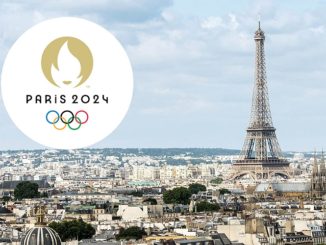
● From our sister site, TheSportsExaminer.com ●
“Stated another way, if Santa Monica hosts Olympic beach volleyball events, it will incur $1.45 million in real cost. In addition, it will miss out on $10.65 million in projected net revenues in a scenario in which the City does not host. The additional $10.65 million represents the City’s opportunity cost of the potential revenues it could benefit from if it chooses not to host Olympic events.”
Real costs of doing something and “opportunity cost” of doing nothing defined an odd economic impact report prepared for the City of Santa Monica concerning the question of whether to have Olympic beach volleyball played in Santa Monica in 2028.
The “Fiscal Impact Findings” report from the economic and public policy consulting firm HR&A Advisors dominates a submittal to the Santa Monica City Council in advance of an 8 October Council meeting, asking for a future “study session” on the question of whether Santa Monica should agree to be the site for beach volleyball.
The City’s 17-page report describes the current situation following a year and a half of negotiations that began in May 2023, with the summary noting with alarm:
“The impact study forecasts that the City would be responsible for $15.54 million in estimated costs to prepare for and host the Olympic Games. If the City were to choose to not host beach volleyball, it stands to gain $10.65 million in fiscal benefits. The City would only generate $2.79 million in additional revenues if it hosted Olympic events but would face significantly higher costs. Overall, hosting beach volleyball could translate to a total net loss to the City of $12.1 million.
“The financial uncertainties related to hosting beach volleyball are compounded by the lack of clarity on the reimbursement terms. Moreover, the Games Agreement also prevents Santa Monica from pursuing alternative revenue opportunities, and precludes traditional revenue sources from both City-hosted special events and privately hosted events by Pier lessees and other local businesses, unless approved by LA28. The potential legal risks associated with signing the agreement are significant, as it binds the City to hosting beach volleyball and limits flexibility to negotiate key terms after the Games Agreement is executed.”
Santa Monica was identified as the site for beach volleyball in the Los Angeles bid for the 2024 and then 2028 Olympic Games, placing a temporary stadium for 12,000 spectators north of the Santa Monica Pier.
At issue now is a Games Agreement between the LA28 organizers and the City of Santa Monica, committing both to use the site for beach volleyball and to be followed by three more agreements concerning city resources, venue services and venue use. Games Agreements have already been reached with Los Angeles, Carson, Inglewood and Long Beach, all of which will have more than one venue.
The HR&A study shows that by not hosting beach volleyball (or any other Olympic event), Santa Monica would benefit from some Olympic hotel traffic – acknowledging it is already at “full capacity” during the summer months. But the study contends that the City will absorb an additional $14.89 million in costs for “security, infrastructure, and event operations” and realize only an added $2.79 million in net revenue during the period.
However, there are a lot of caveats to the HR&A projections. The City report notes:
● “The fiscal impact analysis does not account for LA28 reimbursing the City for enhanced municipal services since there are currently too many unknowns.” LA28 has promised to do this.
● “LA28 has indicated that there would also be a ‘games footprint,’ a currently undetermined area beyond the venue footprint where the City would be reimbursed for providing enhanced City services.” The exact breadth of the area and reimbursement to be made is as yet undetermined.
Further, HR&A created an unsupported revenue projection for Santa Monica hosting beach volleyball that says 2028 Olympic visitors will act the same as those who came without the Games in 2024:
● The HR&A report estimates 381,000 ticket holders for beach volleyball and estimates that the number of day-trip visitors to Santa Monica in 2028 would be 642,000 for the Games period vs. 245,000 for 2024.
Also, the number of overnight visitors would increase only from 53,000 to 59,000 from 2024 to 2028, as Santa Monica accommodations are already close to capacity as it is during the summer.
● HR&A’s revenue estimate for 2028 Olympic visitors, ignoring inflation from 2024, is that they will spend exactly the same as non-Olympic visitors in 2024. Actually slightly less: the 642,000 day-trip visitors projected for 2028 are 2.62 times the number for 2024 and the revenue to be received is estimated at 2.60 times: $22.6 million against $8.7 million.
The contribution shown from overnight visitors is trivial: an increase from 53,000 to 59,000 visitors (+11.3%) will produce additional revenue of just $89.7 million in 2028 as against $86.7 million in 2024: 3.5% more. Amazingly, no added revenue is shown for occupancy taxes for the 6,000 added visitors in 2028, across 15 days!
That’s not what was seen in Paris, another cosmopolitan city which just hosted an Olympic Games this summer. Multiple shopkeepers complained their business fell during the Games, because the visitors were concentrated on the Olympics, not buying jewelry or paintings. They focused on having a good time:
● The French-language site FrancsJeux.com reported in September on data from France’s second-largest banking concern, Groupe BPCE, which estimates that it handles about 20% of all credit-card transactions in the country. The report for the Ile-de-France region – which includes Paris – showed marked increases in spending overall during the Olympic Games.
● For tourism and cultural activities, “a 58% increase in spending by the French during the two weeks of the Olympic Games, then 30% during the Paralympic Games, compared to the same periods in 2023.” (Computer translation from the original French.)
● “An increase, but less marked, was also measured in the fast food sectors (+9% and +12%), bakeries (+14% and +16%), bars (+6% and +4%), and restaurants (+4% and +5%). Clearly, the Games encouraged the French to go out more often, and therefore to spend more.”
● “Another lesson from the BPCE barometer: foreign visitors massively frequented bars and restaurants in Paris and its region. Their spending was significantly higher than that recorded during the same period in 2023, up 40% in restaurants and 52% in bars at the time of the Olympic Games, then 10% and 26% during the Paralympics.”
The HR&A study assumes that the Olympic Games in Santa Monica will have no economic impact other than having more people present. That’s not what happened in Paris, and anyone who has been to the Santa Monica Pier area is well aware of the vast eating, drinking and entertainment options available close by. And beyond those increases in sales are the local taxes that accompany them, 10.25% in Santa Monica.
The HR&A study further makes some strange projections on expenses, comparing a 15-day, two-sessions-per-day Olympic beach volleyball program to a 2017 concert series, which was a free event held on the Santa Monica Pier, scheduled for eight shows across nine weeks (the report mentions six shows).
This series was put on by the City of Santa Monica itself on its own Pier, making a comparison on costs with the Olympic beach volleyball tournament in 2028 – to be produced by the LA28 organizing committee in a venue it will create and operate – apples and kumquats. In fact, as Santa Monica has no NCAA or professional sports teams at all, it’s impossible to compare costs with anything that happens there, especially from prior to the Covid pandemic.
The HR&A multiplier approach from the 2017 concerts to the 2028 beach volleyball tournament creates a wholly unreliable cost figure ranging from $10.95 to $17.73 million, a 62% spread!
One example: HR&A used its own 2017 series attendance estimate of 398,634 – an average of 49,829 across eight shows – to create a waste management cost figure of $335,611. But Los Angeles Magazine reported in a 15 November 2017 online post, three months after the series ended:
“An average concert at the Pier draws a crowd of 8,000 to 10,000 attendees,” except for the 22 June 2017 performance by Khalid, which drew a reported 60,000, but “independent auditors estimated actual attendance at about 25,347 based on tallies and digital reconstructions from the event.” So perhaps the HR&A series attendance estimate of almost 399,000 might really be less than 100,000 (25%) for the 2017 series? Why wasn’t a City of Santa Monica attendance report used? Are the 2028 projected expenses of $11-18 million all off by 75%?
The HR&A report significantly underestimates revenues and has no reliable formula to project expenses related to a 2028 Olympic beach volleyball tournament. It made some guesses, but they can hardly be taken as fact.
As for actual financial concerns for Santa Monica, the City Report notes a legitimately worrying provision in the proposed Games Agreement:
“[T]he Games Agreement only requires LA28 to reimburse the City if LA28 has net revenues available to do so. While LA28 and City of Los Angeles representatives have publicly stated on multiple occasions that they anticipate the 2028 Summer Games will result in a budget surplus, that cannot be guaranteed at this time.”
There are real issues here, and the City staff’s call for a “study session” on the question of the 2028 Olympic Games and Santa Monica is the right approach to try and find a well-thought-out solution.
For Santa Monica, and for the LA28 organizers. Let’s be real: in Southern California, of all places, there are plenty of iconic spots to play beach volleyball.
~ Rich Perelman




Be the first to comment